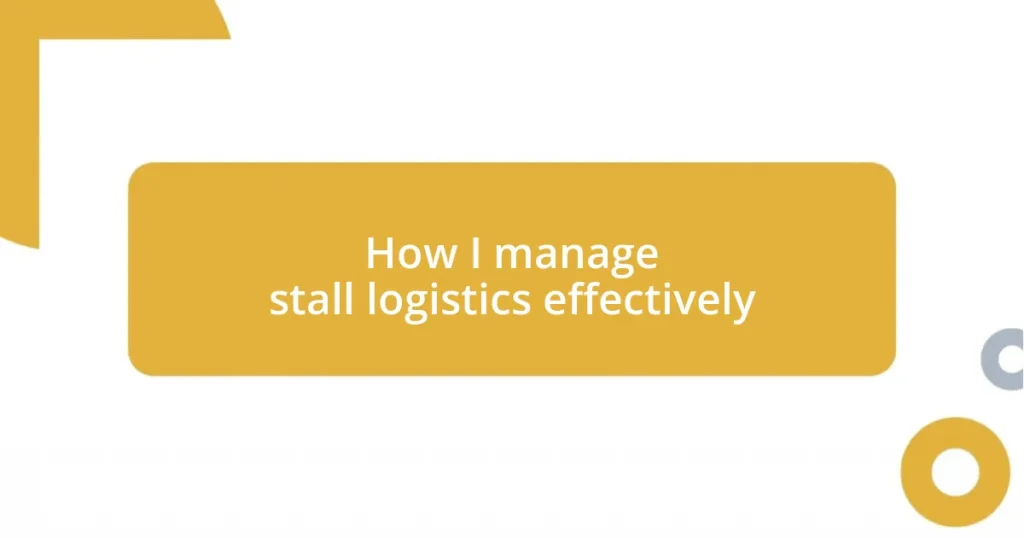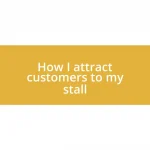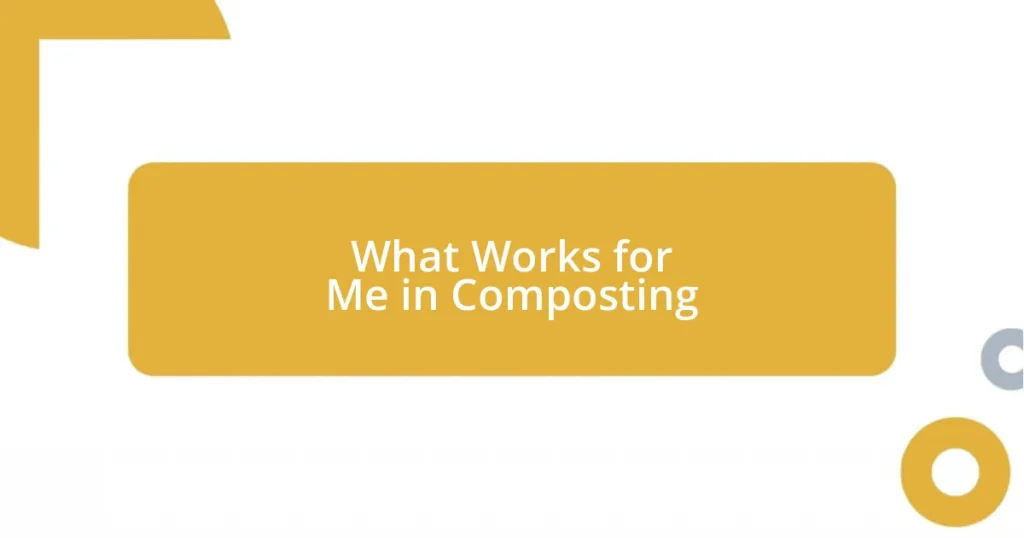Key takeaways:
- Clear communication with vendors and staff is vital to prevent logistical issues and ensure smooth event management.
- Proactive planning and flexibility, including having contingency plans and utilizing technology, enhance logistical efficiency.
- Regular evaluation of logistics performance through KPIs and feedback can identify improvement areas and lead to better future events.
- Fostering relationships with local suppliers and vendors helps create a supportive network and improve logistics collaboration.

Understanding stall logistics needs
When it comes to understanding stall logistics needs, I always start by asking myself what the unique requirements are for each event. For instance, I remember a large outdoor festival I organized. The weather was unpredictable, and I had to ensure that all materials were protected from potential rain. This experience highlighted the importance of anticipating specific logistical challenges that could arise.
Additionally, I’ve found that communication with the stall vendors is crucial. One time, a vendor arrived with equipment that wasn’t compatible with our designated space, leaving me scrambling for a solution. These situations taught me the value of clear communication well in advance, ensuring that everyone involved knows what to expect and what is needed for a smooth setup.
It’s also essential to take into account the flow of foot traffic around the stalls. For example, during a local artisan fair, I noticed how some stalls had fewer visitors simply due to their placement. It got me thinking: how do we ensure that all stalls receive equal opportunities? Observing patterns and gathering feedback can really inform not just this event, but also future logistics planning.
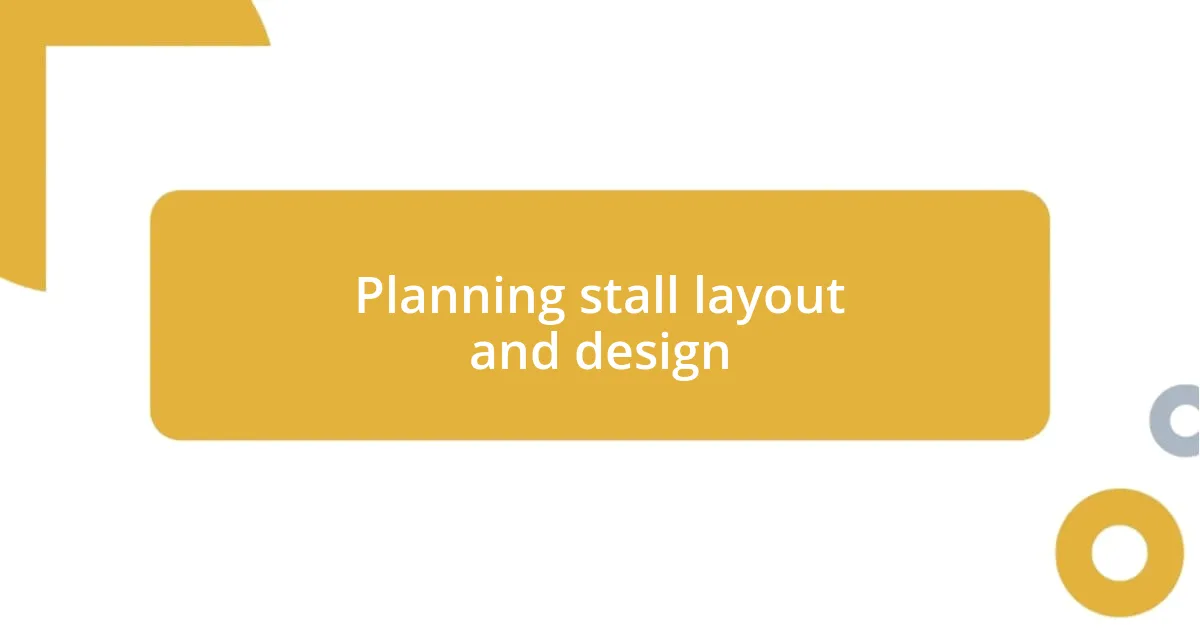
Planning stall layout and design
When planning a stall layout and design, I always envision how the space will look and feel to attendees. A few years back, I set up a community fair where I strategically placed stalls to maximize engagement. By arranging vibrant displays at focal points—like the entrance—I could guide foot traffic seamlessly and create an inviting atmosphere. Keeping aesthetics in mind alongside functionality can really elevate the experience for both vendors and visitors.
Here are some key considerations that I always keep in mind:
- Flow of Traffic: Design pathways that facilitate a smooth movement, ensuring stalls don’t block access to one another.
- Accessibility: Make sure stalls are accessible to everyone, including individuals with disabilities.
- Visual Appeal: Use colors, lighting, and signage to attract attention and create an appealing environment.
- Vendor Needs: Discuss with vendors their space requirements, including power sources and storage.
- Safety: Ensure that layout meets fire and safety regulations, providing clear exits in case of emergencies.
By focusing on these aspects, I find that the overall impact of the event improves significantly. It’s a process that requires both creativity and practical thinking.

Scheduling staff and resources
When scheduling staff and resources, I always prioritize clear communication. I’ve learned that when everyone knows their specific roles, the setup process is much smoother. For instance, during a food festival, I assigned a lead person to coordinate the delivery of supplies while ensuring vendors had their shifts covered. The anticipation of potential issues really shaped how efficiently the event unfolded.
Flexibility is another crucial factor in my scheduling approach. There have been times when weather or last-minute changes forced me to rethink staffing. One memorable instance was during a rainy day at a craft fair—adjusting shifts on the fly and ensuring enough coverage allowed us to maintain operations without compromising service. I firmly believe that being adaptable can significantly impact success.
Lastly, I utilize digital tools to streamline scheduling. A few months ago, I implemented an online scheduling platform, allowing staff to easily see their shifts and request changes. It’s streamlined communication and drastically reduced confusion. Embracing technology in this way has transformed my scheduling process and made it more efficient for everyone involved.
| Aspect | My Approach |
|---|---|
| Communication | Ensuring everyone knows their roles to enhance efficiency |
| Flexibility | Ability to adapt to last-minute changes ensures smooth operations |
| Technology | Utilizing digital tools for scheduling reduces confusion and streamlines processes |

Tracking inventory and supplies
Tracking inventory and supplies is one of the cornerstones of effective stall management. I remember a time at a local arts and crafts festival when I double-ordered certain supplies because I lost track of what I already had in stock. That experience taught me the importance of real-time inventory tracking. It’s amazing how a simple spreadsheet or an inventory management app can prevent costly mistakes and ensure I have exactly what I need when the event kicks off.
In my experience, having a reliable system in place significantly reduces stress on the day of the event. I often find it helpful to create a checklist that includes everything from booth materials to promotional items. When I was preparing for a food market, I used a color-coded system that made it easy to see what was accounted for at a glance. Isn’t it reassuring to know that everything is organized, especially when the clock is ticking down to the opening?
Moreover, I’ve realized that regular audits of supplies help keep everything in check. After noticing discrepancies between what I thought I had and what was actually available, I started conducting quick inventory checks weekly leading up to an event. This proactive approach gives me peace of mind and allows me to adjust orders in time to meet any last-minute needs. How do you keep track of your inventory? I genuinely believe that finding a system that works for you can be a game-changer.
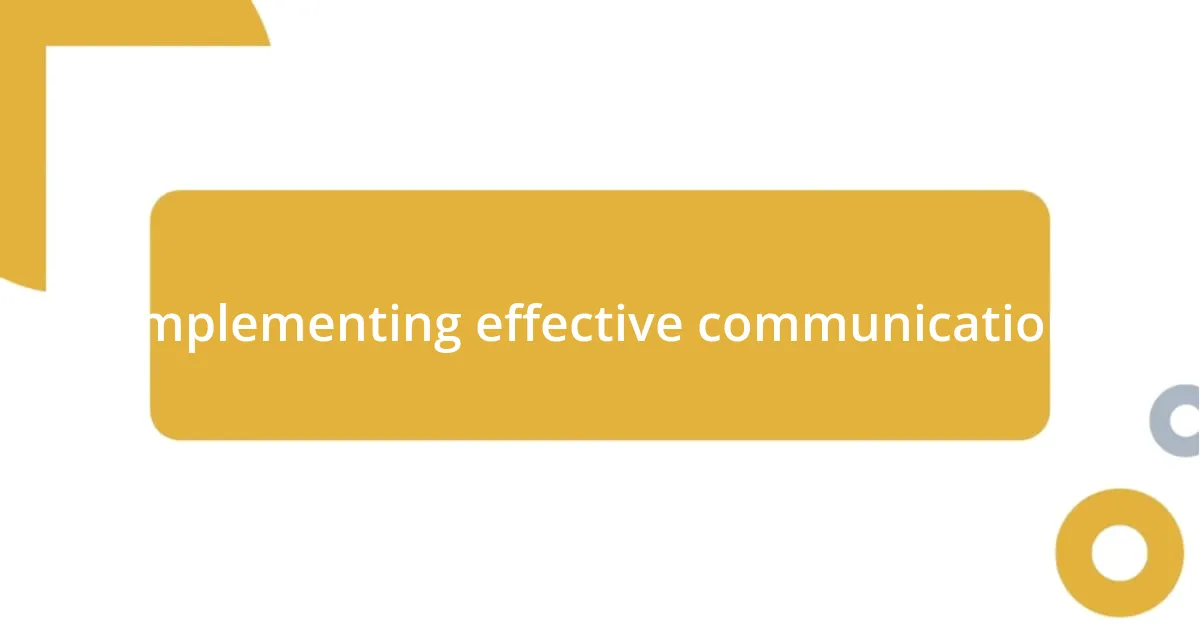
Implementing effective communication
Effective communication is essential for ensuring that everyone involved in an event is on the same page. I remember a particularly hectic day at a street fair when clear communication kept chaos at bay. By regularly checking in with my team through brief, focused huddles, I could address concerns before they spiraled into bigger issues. Isn’t it fascinating how a simple strategy can foster camaraderie and boost morale?
In my experience, I’ve found that using various channels for communication—like group messaging apps and face-to-face discussions—can cater to different preferences and needs. Recently, during an outdoor festival setup, I noticed that some vendors felt overwhelmed with their tasks. By quickly shifting from texting to face-to-face conversations, I could clarify instructions and alleviate their worries. How often do we forget that personal touch in our digital age?
I also believe that feedback loops play a vital role in enhancing communication. After each event, I gather insights from my team about what worked and what didn’t. This reflection session always sparks robust discussions and generates new ideas. For instance, one team member suggested implementing a shared checklist post-event, which has helped streamline our processes for future installments. Isn’t it empowering to involve everyone in shaping the way we operate?
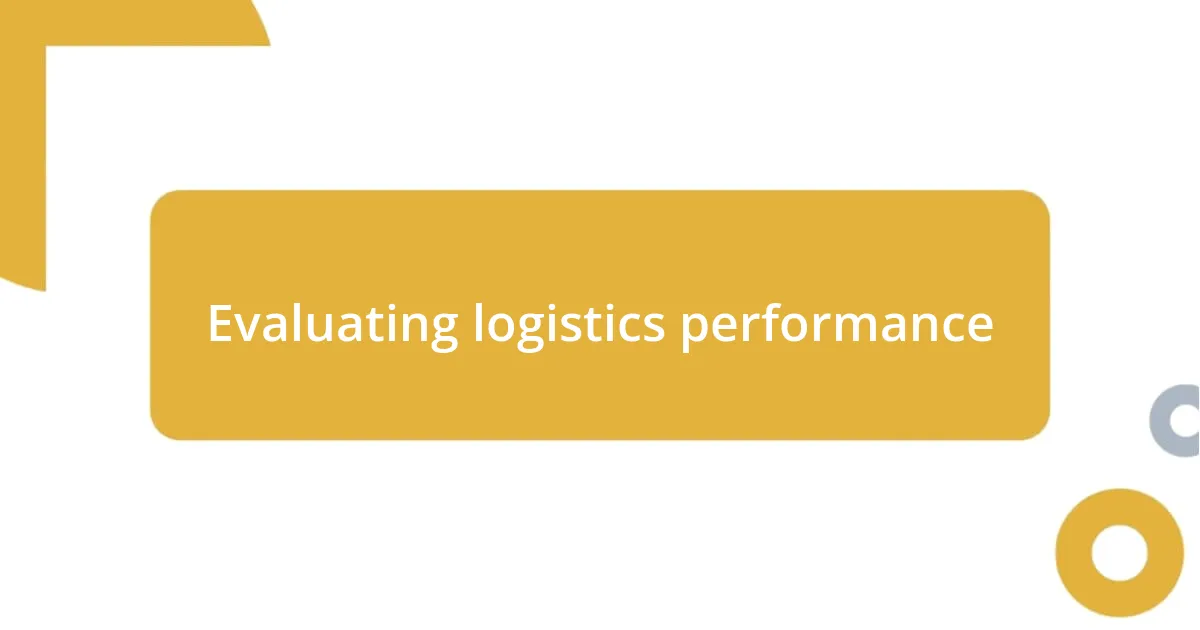
Evaluating logistics performance
Evaluating logistics performance requires a systematic approach to measure success and identify areas for improvement. I remember a time when I took a step back after an event and analyzed everything—delivery times, inventory turnover, and even customer feedback. It was eye-opening; I discovered that while our setup was efficient, our supply ordering process had room for significant improvement. Have you ever noticed how reflecting on the details can unveil hidden insights?
Key performance indicators (KPIs) can be invaluable in this evaluation. I typically track metrics like order accuracy and the time it takes to restock supplies. For instance, during a bustling craft fair, I was able to pinpoint that our five-hour restock time was causing delays in service. Addressing this helped us improve our response time, leading to happier customers and smoother operations. Isn’t it incredible how numbers can tell such compelling stories about our performance?
Regularly seeking feedback from both my team and customers also shapes my evaluation process. After one particularly challenging weekend market, I sent out a quick survey to my team. To my surprise, their insights on communication gaps led to the implementation of a simple messaging template that enhanced clarity. Sometimes, I think we overlook the value of collective wisdom; how often do we take the time to listen and adapt based on our teams’ experiences?

Improving logistics for future events
Improving logistics for future events hinges on proactive planning and adaptability. For instance, during one event, I faced a last-minute vendor cancellation that threatened to derail our setup. Instead of panicking, I quickly contacted a backup vendor I had previously vetted. This experience taught me the value of having contingency plans in place—something I now prioritize in my event preparations. Have you ever found comfort in knowing you have a plan B?
Moreover, investing in technology can significantly streamline logistics. I started using event management software to monitor tasks and track inventory in real time. When I first introduced this tool at a local festival, I was amazed at how it cut down on miscommunication. It’s easy to overlook the impact of tech solutions in a hands-on environment, but they can be game-changers for efficiency and responsiveness. Have you considered how technology could elevate your logistical operations?
Lastly, I believe that fostering relationships with local suppliers and vendors is crucial for continuous improvement. By nurturing these connections, I can gain valuable insights into their capabilities and any potential challenges they might face. After a successful collaboration with a catering service, we regularly brainstormed ways to enhance our processes together. Isn’t it powerful to leverage partnerships for mutual growth? These interactions have not only strengthened our logistics but also built a community that thrives on shared success.










